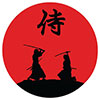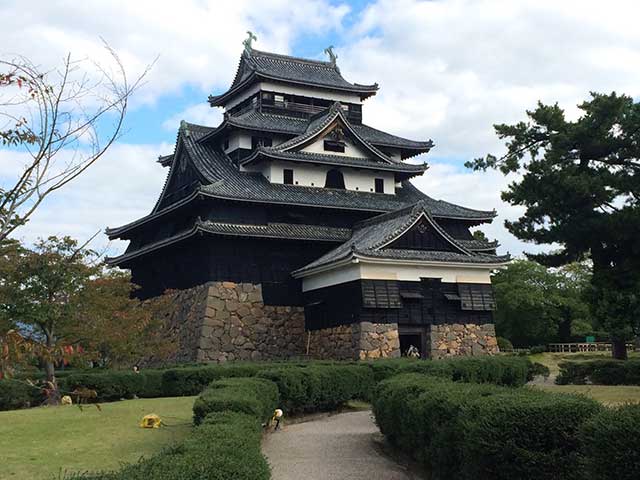
There was once a rule prohibiting girls from dancing in the streets of Matsue City. According to legend, if they did, the base of Matsue Castle, the city's symbol, would begin to shake, endangering the towering structure. The legend suggests that Matsue Castle’s Ishigaki stone walls contain a Hitobashira, a human sacrifice entombed within the stonework to act as the castle's guardian spirit. In this case, the Hitobashira was a young girl who loved to dance, and to prevent the castle from ever collapsing, a law was passed prohibiting girls from dancing in the streets, thus avoiding upsetting the spirit within.
Also known as Chidori-Jo, or Plover Castle, Matsue Castle in Matsue City, Shimane Prefecture, is one of just 12 keeps remaining in original condition and one of five National Treasure-registered castles. Situated high atop Mt. Kameda on the northern banks of Lake Shinji, Matsue Castle was built by Horio Yoshiharu (1544-1611), previously the castellan of Hamamatsu Castle, and his son Tadashi (1578-1604). The Horio clan was awarded the domain for their meritorious deeds in the decisive Battle of Sekigahara in 1600. Construction began in 1607 and was completed five years later. Horio Tadashi died without an heir, and the Horio clan ended in 1611 with the death of his father, Yoshiharu.
Kyogoku Tadataka then became the Lord of Matsue, followed in 1638 by Matsudaira Naomasa (1601-1666), a grandson of Tokugawa Ieyasu, whose descendants ruled until 1871 when the castle was abandoned. Except for the main tower, all surrounding defensive watchtowers, gates, and other structures were demolished in 1875.
Matsue Castle had just eight yagura watchtowers and four gates, which was relatively few for such a large and important castle. However, its Renkaku-shiki layout, hilltop positioning, wide moats, numerous canals, steep embankments, and high ishigaki stone walls provided sufficient defense.
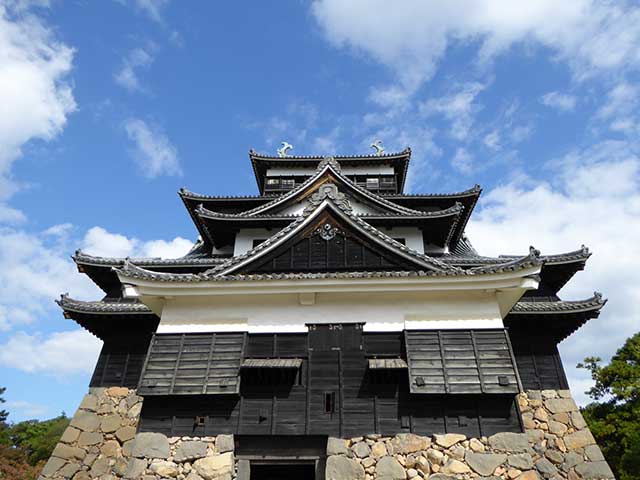
Standing 23 meters above the seven-meter-high stone tenshu-dai base, Matsue Castle’s tower keep is a fine example of an early Edo period tenshu with five levels concealing six inner floors and an underground basement. Access is via the forward-protruding tsuke-yagura, adjoining the basement. The interior is maintained in excellent condition and contains a fine collection of samurai helmets, armor, weapons, and items of historical interest. Unlike most castles, the main support pillars of Matsue Castle are constructed from multiple timber beams fastened together with staple-like hooks called Kasugai.
The keep is a borogata type tenshu, or watchtower style, similar to the towers of Inuyama, Maruoka, and Nakatsu Castles. Borogata towers resemble temple hall construction, with towers built onto the center of the roof. Matsue’s tower keep has two levels under a temple-like irimoya roof, with a tower section raised on top. The exterior of the lower sections is covered in black shitami-ita, blackened wood paneling protecting the wattle-and-daub-type mud walls beneath, giving the castle an older appearance. Matsue Castle has ishi-otoshi stone-dropping chutes set on the second floor, hidden by the first tier of roofing, a trait shared only with Nagoya Castle. Incidentally, Matsue’s copper-plated rooftop shachi-hoko tiger-fish ornaments are 2.25 meters high, second only to Nagoya Castle. Another point of note is the kato-mado, the elegant candle flame-shaped central window above the second floor roofing and below the third floor’s triangular hafu curved roof gable, adding an attractive design to the otherwise stoic, geometrical structure of the keep.
Interestingly, while most castle eaves are plastered under the edges to cover the wooden beams and panels and prevent fire from spreading, Matsue Castle’s eaves are not plastered, leaving the plain, exposed wood visible from below. The view from the large, open windows on the top floor provides a clear panorama of the town, rivers, and moats below.
See also
-
Iyo Matsuyama Castle
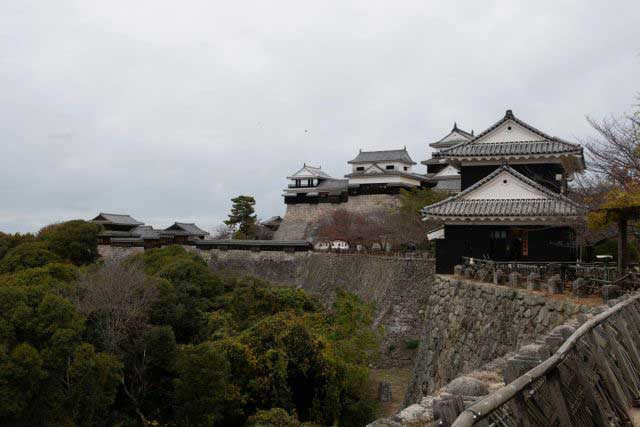
Historically, the center of Iyo Province—corresponding to today’s Ehime Prefecture on the island of Shikoku—was the city of Imabari, while the Matsuyama area was regarded as an agricultural hinterland with broad plains and low hills. During the Muromachi period, the central part of the province was governed by the Kano clan from Yuzuki Castle. With the onset of the Sengoku period, however, this clan lost its former influence and was forced to survive in the shadow of the more powerful Mori and Chōsokabe clans. After Toyotomi Hideyoshi’s forces conquered Shikoku in 1587, the northern part of Iyo Province was granted to Fukushima Masanori, one of the so-called “Seven Spears of Shizugatake.” In 1595, Masanori was transferred to Kiyosu Castle, and the lands around Matsuyama were given to another of the Seven Spears, Katō Yoshiaki, who received Masaki Castle and an income of 60,000 koku of rice.
-
Kanazawa Castle
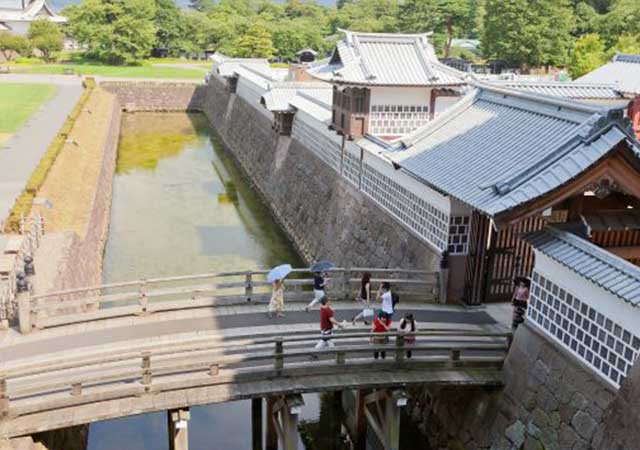
Construction of Kanazawa Castle began in 1580 on the orders of Sakuma Morimasa, a vassal of Oda Nobunaga. The castle was built on the site of the Ikko-ikki sect's Oyama Gobo temple, which is why it is sometimes called Oyama Castle. Morimasa managed to build several moats and begin construction of a castle town. However, after his defeat at the Battle of Shizugatake in 1583, he was executed, and ownership of the castle passed to Maeda Toshiie (1538–1599).
-
Nakatsu Castle
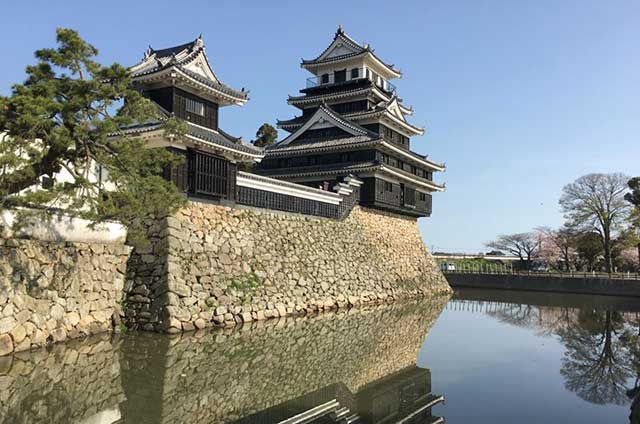
Kuroda Yoshitaka (1546–1604) was one of the closest advisors to the legendary military commander Toyotomi Hideyoshi. He took part in key military campaigns of the late 16th century, including the campaign against Shikoku in 1585 and the campaign against Kyushu in 1587. Later, during the second campaign in Korea, Yoshitaka served as chief advisor to the commander of the invasion forces, Kobayakawa Hideaki. After Hideyoshi's death, he swore allegiance to Tokugawa Ieyasu, thereby securing his influence and patronage under Japan's new leader.
-
Edo Castle
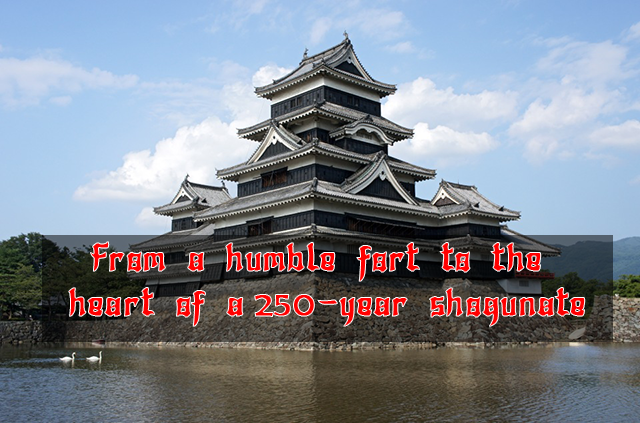
The history of Edo Castle dates back to the Heian period, when the Edo clan built a small fort on this site. In 1457, the vassal of the Uesugi clan, Ota Dokan (1432–1486), constructed a full-scale castle here. Internal conflicts weakened the Uesugi clan, and in 1524, Ota Dokan’s grandson, Ota Yasutaka, surrendered the castle without resistance to the forces of Hojo Soun, the ambitious leader of the Hojo clan. While Odawara Castle remained the clan's main stronghold, Edo was considered a key strategic fortress.
-
Samurai Museum Shinjuku

Situated in the vibrant district of Shinjuku, the museum showcases an extensive collection of samurai armor, weapons, and cultural artifacts spanning from the Kamakura to the Edo period. The exhibits aim to convey the samurai's unwavering commitment to honor and discipline, reflecting how their spirit continues to influence modern Japanese culture.
-
Anjo Castle

Anjo Castle was built on a slight elevation at the edge of the Hekikai Plateau, about 2 kilometers southeast of present-day central Anjo City in Aichi Prefecture. Today, the surrounding area thrives on large-scale agriculture and automotive manufacturing, utilizing the expansive flatlands and its proximity to the Nagoya region.
-
Numata Castle
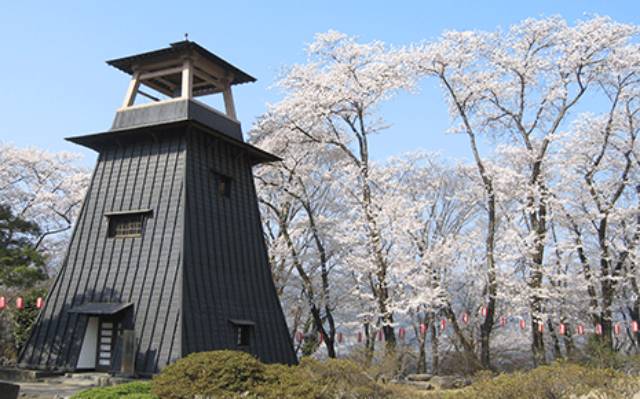
Numata Castle, located in Numata, northern Gunma Prefecture, Japan, has a rich and complex history. During the late Edo period, it served as the residence of the Toki clan, who ruled the Numata Domain. Over the centuries, the castle changed hands multiple times and was the site of significant battles during the Sengoku period.
-
Iwabitsu Castle
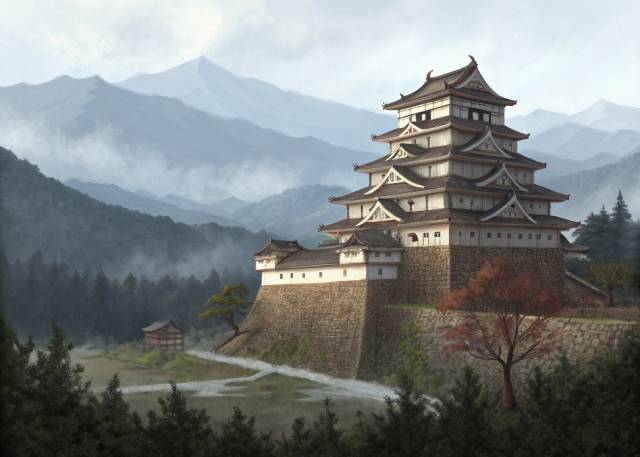
Iwabitsu Castle is a yamashiro-style (mountain) castle located atop Mount Iwabitsu in Higashiagatsuma, Gunma Prefecture, Japan. Recognized for its historical significance, its ruins have been protected as a National Historic Site since 2019.

